
Sunny days in Shanghai
A fairly whirlwind few days in Shanghai saw me head out to the factory around 20 miles outside the centre of the city on day one to check on progress for our next container of Classical Chinese furniture. This will be our last shipment leaving here before Christmas and I had timed my visit to allow me to see most of the furniture nearing completion.
I was pleased to see that nearly everything was already finished, if only to the ‘woodwork’ stage, which actually provides a good opportunity to check on the quality of the joinery and construction of each piece as the craftsmanship is more evident before a final finish is applied – particularly on solid lacquer pieces.
As always, we also have several bespoke items of furniture due to ship this time, made to order for customers with specific requirements in terms of size, style or finish. I was able to discuss final details on one or two of these pieces and I look forward to seeing photos of the finished results in a week or so before we finalise everything for shipping later this month.
| Checking bespoke console table | Workers in the factory | Furniture waiting for lacquering |
Saturday was a beautiful day in Shanghai and I had time to head out for a stroll along the waterfront at the Bund and down Nanjing Road to People’s Square – something I’ve not done for a few years. The Bund provides the classic backdrop of colonial era Shanghai, with its imposing deco buildings that were built to house the banking and trading organisations of the western settlements.
Looking across the Huangpu River to the newly developed area of Pudong, including the iconic Pearl Oriental Tower, the contrast between old and new is striking. Once an emblem of western power and influence, the old colonial buildings are now dwarfed by the gleaming steel and glass skyscrapers across the water, most of which have been built only over the last twenty years or so as the Pudong area has been opened up for development.
Among the huge throng of tourists enjoying the view were many brides to be, dressed up in their finery for wedding photos against the stunning background of the Shanghai skyline. This is something I’ve mentioned in a previous blog post on an earlier trip and a concept that is quite strange us in the west. Photos here are taken weeks in advance of the big day, with the bride, groom and bridesmaids all turning up in full paraphernalia. I guess it is one less thing to think about on a bride’s wedding day but it always seems somehow fake to my mind as the photos don’t have any real connection to the actual wedding other than the outfits, which are usually hired solely for the photos!
I also paid a visit to the Jing’an Temple, the large Buddhist temple on Nanjing Road. Originally built in the thirteenth century, it has been rebuilt and renovated many times and even served as a plastics factory during the Cultural Revolution. Made up of four halls, each one includes a wonderful statue of the Buddha in either stone, jade or camphor wood which date from as long ago as the 5th century. Built in a courtyard style, the architecture is wonderful, with carved lattice door and window panels all around and pagoda roofs.
Set in the noisy, bustling centre of Shanghai and so close to the hugely commercialised, crowded main drag of Nanjing road, the temple felt like a tranquil oasis – a great place to reflect and gather your thoughts before heading back into the throngs of people outside and the stresses of modern life.
| Jing An Temple | Jing’an Temple Architecture | Bride to be against the Pudong skyine |
On Saturday evening I went over to Xintiandi, an area not far from People’s Square that has been developed recently to house a myriad of bars, restaurants and shops. One of the most expensive places to live in the city, the area has become one of the main social centres and is a gathering place for ex pats and wealthy Chinese alike. It’s a great place to wander around and, along with the little shops selling mostly overpriced clothing and homewares, there are a couple of interesting little museums.
The whole area has been redeveloped based on the original old ‘shikumen’ (stone gate) courtyard houses and one of these (the Shikumen Open House Museum) essentially resconstructs what life would have been like in one of the houses at the beginning of the 20th century. The house is furnished as it would have been, with antiques and artefacts from the time. It is beautifully done and well worth a look.
There are other hidden gems in the area. I took a detour into an entranceway and up some stairs to find myself in the elegantly presented showroom of a company specialising in nanmu furniture. Nanmu is a beautiful wood used over centuries in China for some of the more refined pieces of furniture – ones that only the most wealthy could afford. We have had a few antiques in the wood ourselves over the years, always beautifully made and, whilst not on the level of the huang huali or zitan pieces that go for tens of thousands of dollars at auction, they are always something quite special. The wood is quite dense, with a tight grain compared to elm, and is very stable in changes of climate.
| Nanmu furniture | Dragon carvings on nanmu cabinet | Nanmu carved cabinets |
This Shanghai company is producing new furniture in the wood based on ancient designs and targeted firmly at the Chinese elite, who are starting to appreciate the classical styles and beautiful materials of their past. Most of us would have to remortgage the house to be able to afford much of the furniture displayed, but the quality and craftsmanship were remarkable. The designs shown included tables, chairs and cabinets that were reproductions of Ming dynasty furniture, with clean lines and simple style. Others were copies of the later Qing dynasty, with very elaborate, heavy carvings. The latter included a pair of huge cabinets, wonderfully decorated with highly detailed carvings of dragons.
I flew to Beijing last night so over the next few days will be catching up with one or two old contacts and visiting warehouses, selecting more Chinese antiques for shipping over to the UK in the New Year. I’ll let you know of any interesting finds soon.


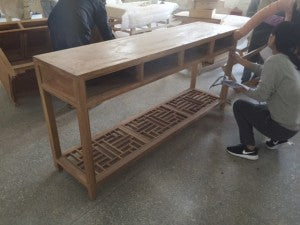
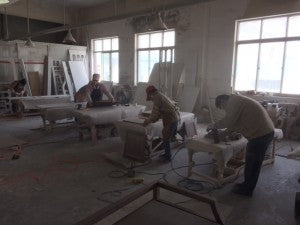
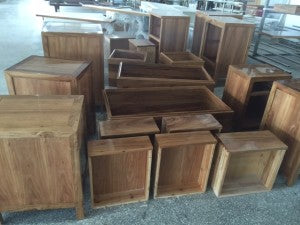
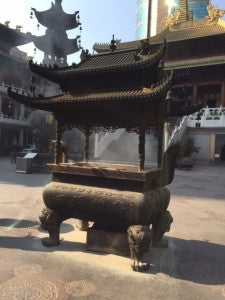
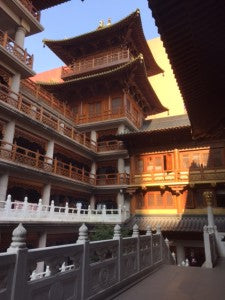
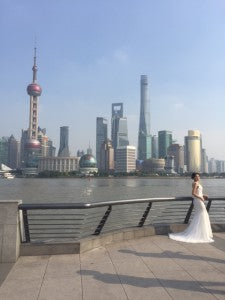
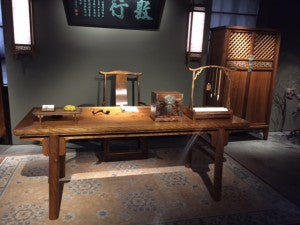





Leave a comment